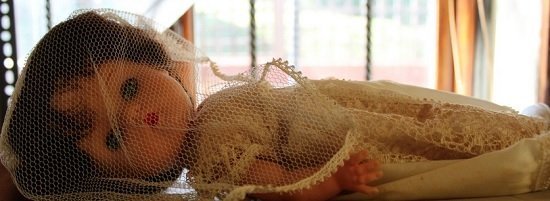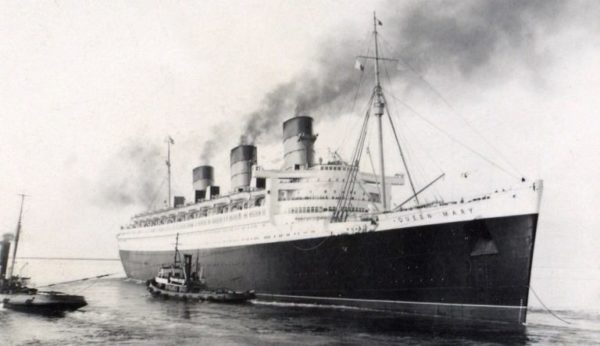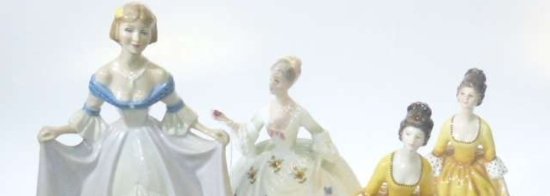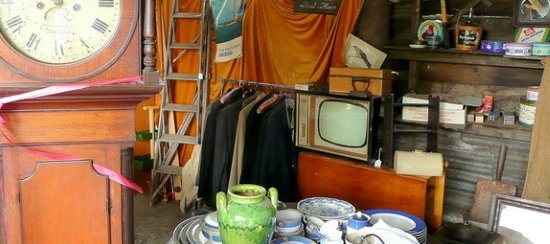Paper dolls not only chronicle the history of fashion, but they aptly chronicle the times. England invented the one-sided figure to be cut-out and played with much in the same manner a child played with a doll. These 8-inch paper people had several sets of clothing and were marketed in 1790 as “English mannequins.” They sold for three shillings.
One hundred years later, in the 1890s paper dolls were well established as a child’s plaything. Raphael Tuck & Sons Company were publishers to her majesty Queen Victoria. They first applied for the right to patent a paper doll on 9 June 1893 (patent No. 11, 367; A. Tuck and F. P Scott submitted drawings/specifications). One portion of the card illustration depicted a tinted baby’s face, arms, and nursing bottle; the other portion consisted of a pattern for a long robe and bonnet to be cut from tissue paper to fit the baby.
Graham & Matlock Publishers, New York, offered a set of “Scissors Play Paper Dolls” in the 1890s which came in sets, i.e., “Mother Goose Set No. 3,” etc. The figures were to be cut out, the parts fit together by inserting dolls or figures in proper positions.
Youth’s Companion magazine, October 1896, presented the “Parisienne Dolls.” This lovely “Evening Gown Series” consisted of a set of five dolls and dresses. These elegant lady types had different wardrobes and were lithographed in the delicate colors and shades of the richest fabrics. They had both fronts and backs and stood 7-inches tall and were given only to Companion subscribers for one new subscription, postpaid, or a sample doll could be had for 12-cents, postpaid. The two-sided gowns could fit down over the ladies’ heads and the round flaring skirts were made up on the folding and creasing technique. When the doll was dressed, the skirt flared out enabling it to stand alone.
Paper doll services were popular in the 1890s. Some of the finest were made by Tuck. Two services in my collection (undated) appear to be ca. 1909, judging from the style of the clothes. One card features “Billy Burton” and his sailor suit and cap; the other features his sister, “Dolly Burton,” and her dress, hat, and slippers. The cards remind us that “Next month Dolly will have a new outfit.”
Also, in 1909, Buster Brown Blue Ribbon Shoes, St. Louis, had Buster Brown and his dog, Tige, for eager youngsters who purchased a pair of shoes. This coveted pair were printed on an advertising card.
McCall’s magazine, October 1909, had a striking Gibson Girl with four gowns, two hats, a muff, and a fur piece. Motion Picture magazine surprised readers with a paper doll of popular actress, Fay Fincher, and her beach wear, in their December 1916 issue. That same year, the Supplement to the Herald, Syracuse, MY, had a page of paper dolls entitled “Sunshine Paper Dolls.” This particular page introduced “Father” and his very elegant wardrobe. Father was two-sided as was his suit, coat, and smoking jacket. (This was one of a series.)
Ladies Home Journal, January 1917, had an advert illustrating “Four Cutout Calendar Dolls.” This set comprised one doll with four costumes forming a complete calendar for 1917. To glean this set, all one had to do was send 10-cents to Swift & Company, 4220 Packers Ave., Chicago, Il., or send trademark ends, labels, covers, or wrappers of various products.
An interesting book, Instructor Jointed Toys Book (1918-1920) featured jointed figures to be colored, cut out, glued to card, and strung together for movement, e.g., heads, bodies, limbs. Two delightful pages depicted “Jointed Toy-Alice and Her Dog.” There were nine others including a boy from Spain, a girl from Brittainy, etc.
Child Life magazine, July 1922, printed an advert for paper dolls for “Rainy Days” created by Margaret Evans Price. These pre-colored dolls were either already cut out and on card standards or uncut. Each doll had three suit combinations. There were boys, girls, and babies that could be yours if you sent $1 to Fish-Lyman Co., Rochester, N.Y. Helen Brough illustrated paper dolls for Child Life in the 1920s.
Little Folks, The Children’s Magazine, never failed to offer a page of paper folk for their devoted little readers. The June 1925, issue revealed a cute little girl with long pigtails, a “Dutch” costume with wooden shoes and a hat, plus two other outfits with hats. Paper dolls, you know, sold magazines! And how!
The Depression years of the 1930s witnessed the demise of many charming old magazines so beloved by adults and children alike. But this grey new world wasn’t entirely grim, there were always the comic strip paper dolls to collect or the enchanting movie star book sets that cost a dime and could be punched out and cut. Paper dolls not only record history but they record the days and years of our younger lives.







